
The "Hacker Tools" article is being updated.
You can still purchase items with the Hacker Tools logo at Cafe Press.
Hacker Tools


Clockwise from top:
Back in the old days of the technological underground, real hackers and phone phreaks were knowledgeable in electronics, and wrote their own code if they needed their computer to do something. These were the days before computers became a household appliance enabling average sheeple to surf the realms of cyberspace blithely unaware of the technology involved in networking, and rant to their CONgress (the opposite of progress) critters about how their kids need protection from evil online purveyors of porn.
Lots of us were young, and had limited financial resources. We needed to be technically adept in order to make use of the equipment we managed to scrounge from various sources. Hardware hacking was (and still is) a respected field of the hobby, and getting an assorted mismatch of parts to work was very fun when it wasn't too frustrating. When I was in high school, I had a part-time job as an electronics technician at the local TV repair shop (I started out as a clerk). Besides making more money than my peers who were slaving away at Roy Rogers, working at a place like that was a great way to pick up free (or dirt cheap) components, test equipment, interesting electronic gadgets, and other hacker toys. As a matter of course I kept in my backpack my Icom IC-02AT ham HT, lineman's butt-set, can wrench, a pair of needle-nose vise-grips, diagonal cutters, a 6" adjustable wrench, and an allen wrench set. That was in addition to the Buck knife and Swiss-Army knife I carried on my person. I would have carried a TRS-80 Model 100 too if I could have afforded one back then. I think a student who carried that amount of hardware into school these days would be considered some sort of terrorist, and that shows how sad things are these days. Nowadays, it appears that most public school students are carbon copies of their sheeple parents. I feel that any parent who does not at least try to get their child somewhat interested in science and technology to be lower than a pedophile, and guilty of child abuse. But I digress.
Back in the old-school days of hacking, hackers actually did more than sit in front a keyboard and play around with scripts and exploits. They went out into the real world to do their hacking. Phone phreaks used to do "phone trips" where they would travel to exchanges serviced by "independent" phone companies to see what they could find. We would go to hamfests to buy our hacking tools, and surplus computers/electronics to go play with.

DTMF (Touch-Tone) Decoder
DTMF tones are used not only for phone dialing, but also for all sorts of signalling and remote control functions. DTMF decoders used to be bulky and expensive devices, but now they are the size of a pager and cost about $100. Most hackers get either the Optoelectronics Tech-Toys unit, or the Digitmaster-Pro unit. My preference is for the Digitmaster unit, as it has a bigger display and is built into a nice metal case. The Optoelectronics unit has a smaller display and is plastic.
Portable Audio Amplifier with Inductive Pick-up - These two units together have many uses. You can:
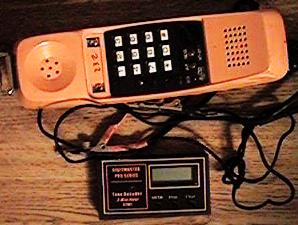
Lineman's Test-Set (Butt-Set)
This is the classic ruggedized test phone with alligator clips and "monitor" mode used by phone company technicians. Many hobbyists improvised their own out of a cheap one piece phone and some alligator clips wired to a modular phone cord. Acquiring a real one was considered a rite of passage for real phone phreaks. Now you can go buy one at Home Depot.
Can Wrench - This is a 7/16" nut driver that is used to open up phone cans. The "official Bell System" ones also had a nutdriver socket on the opposite side for the binding posts on old demarcation points.
Multi-bit Screwdriver and Tamper-Proof Bit Set - The demarc points that don't need a 7/16" nut driver use a 5/32" tamper proof allen wrench. This is the same fastening hardware you see on payphones. For $20-$30 you can buy a bit set that will open most "tamper proof" fasteners (allen, torx, etc.) used in telecommunications systems and electronic hardware.
Prepaid Calling Cards - Always handy for making modem calls from payphones.
Leatherman Tool (or Gerber Multi-Plier) - The pocket tool-kit that replaced the Swiss Army Knife.
Tone Trace Set (a/k/a "Fox & Hound") - Consists of a tone generator and an inductive amplifier. Lets you physically trace and identify a phone line from the modular jack inside, to the demarc point, to the phone can down the road.
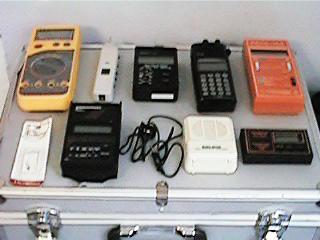
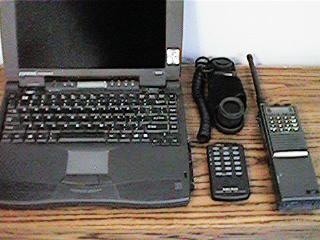
LEFT: Laptop computer, Konnexx Koupler for online connectivity from places where one cannot plug into a modular jack (payphones, some hotels). Radio Shack 43-146 Pocket Tone Dialer (unmodified for those who are wondering), for travels into remote areas (Adirondacks, Berkshires, White Mountains) where rotary phones still exist. Icom H-16 VHF HT; a field-programmable unit than can be used on ham or business band/MURS frequencies.
RIGHT: Some test equipment. Starting at the top row, we have from left to right: Radio Shack 22-805 PC Interface Multimeter, Radio Shack 22-310A ProbeScope, Aceco FC3002 Frequency Counter, Icom R-10 Receiver, and a Russian PKCB-104 Geiger Counter. The bottom row shows a Radio Shack 271-110A 10K Ohm Termistor, Optoelectronics M1 Frequency Counter, "Inductive Pickup" Microphone (Radio Shack et. al.), Radio Shack 277-1008C Mini Amplifier/Speaker, and a Digitmaster Pro Touch-Tone Decoder. The multimeter, ProbeScope, R-10 Receiver, and frequency counters are all capable of being hooked up to a PC for data acquisition and logging of various electric and electromagnetic signals. Similarly, the thermistor can be used with the multimeter for temperature logging. The Aceco frequency counter can be connected to the Icom R-10 for "reaction tuning", the detection and simultaneous monitoring of nearby "near field" radio signals.
Portable DTMF Pad - Back in the days before DTMF was commonly used on phone lines, and many people still had rotary phone service you needed to have a portable DTMF generator in order to use things such as long distance service dial-ups, voice mail systems, and WATS extenders. You could also scam phone calls out of COCOTS (before dial tone detector circuits became standard equipment) and ATM help phones. Later on, someone discovered that you could convert a certain model of DTMF pad sold by Radio Shack into a red box by changing the value of the unit's oscillator crystal. You also used portable DTMF pads to access certain functions (such as autopatch) on ham repeaters before DTMF signaling capability became a standard item on ham HTs. About a year ago, I was at this farm in rural Massachusetts and needed to make a phone call. I went to use my calling card and discovered that the farm's POTS line still had rotary service. My grandparents' place in upstate NewYork is still has rotary party line service, which is entertaining at times. I remember when their exchange (in area code 607) was on a Step-by-Step switch. Since DTMF service is a standard thing for the most part, there isn't much need for portable DTMF pads. Radio Shack discontinued them, sold them off for a couple bucks each, and having lost mine years ago I decided to get another for old-times sake. Some older electronics stores may still have them lying around.
Geiger Counter - In my old stomping grounds is a lake in Pawling, New York called Nuclear Lake. It is on property that was the location of a company who did nuclear research for the U.S. Government. They had an accident there, and the place was closed down. Supposedly the contamination has been cleaned up, and now the Appalachian Trail goes past the lake. A popular hobby among old school hackers is taking a Geiger counter and seeing if they can find any local "hot" spots. A lot of us that were hams in RACES (especially within a nuke plant EPZ) would sign out a radiological detection kit from the local civil defense office and go play with it.
Police Scanner - Lets you listen in to all sorts of interesting communications: police, utility companies (phone, cable, electric), wireless microphones, mall security, and other interesting businesses. If you wanted to break the law, you could also listen in to some cordless phones (not that we advocate breaking the law, however stupid it may be).
Communications Receiver - Kind of like a police scanner, but has greater frequency coverage and receives more communications modes. Used for identifying and listening to various radio signals. Basicly if you want to keep track of the locals, you use a scanner. If you want to track and identify RF signals, you use a communications receiver.
Handheld Ham Transceiver - Getting one's ham license was considered a minor "rite of passage" among old-school hackers, as it gave a convenient excuse for possessing all sorts of weird electronics devices. The rigs are typically modified to allow operation outside the ham bands, allowing them to be used on the license-free MURS frequencies or some other out-of-the-way place on the RF spectrum. Of course, if you and your buddies all have their ticket, you could also use them for your intended purpose and get on one of the two-meter repeaters that are so under utilized these days. You can still find those discontinued Radio Shack simplex repeaters that you can hook up to an Icom or Alinco (or Radio Shack) HT to act as a range-extender. If you can't communicate between two points, find an elevated spot somewhere in the middle and leave a simplex repeater there.
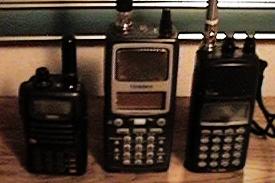
Left: Yaesu FT-50 dual-band ham HT, Uniden BC-250D scanner (APCO P-25 & trunking capable), Icom R-10 communications receiver (from LtoR)
Right: Information Security Associates ECR-1, 0-1000 MHz. Countermeasures (TSCM) Receiver (Spectrum Analyzer) and el-cheapo B&W portable TV/composite video monitor.
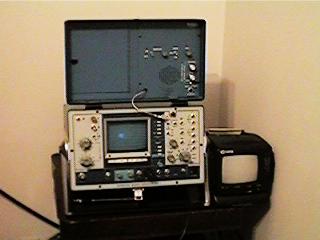
Spectrum Analyzer - Probably one of the more versatile pieces of test equipment a hacker could own.
Oscilloscope - This is yet Another useful piece of test equipment.
If you have no idea of what an o'scope and spectrum analyzer are, then go learn something.
Handheld Frequency Counter - This piece of RF test equipment is very useful for determining the frequency of a nearby transmitter. Certain models such as the Optoelectronics Scout or the Aceco FC3000 series can also automatically tune certain communications receivers (such as AOR or Icom) to the frequency they detect, or send frequency data to a PC.
Multimeter (VOM meter) - The piece of test equipment that forms the basis of the hacker's workbench. For under $100 you can purchase one that will interface to a PC, and enable you to log voltage, current, and resistance measurements over a period of time. You can hook up a thermistor, and measure temperature over a period of time. You can hook up the meter to your phone line, and detect line voltage irregularities that might indicate tampering or the installation of certain bugging devices. You can also hook the meter up to your AC line, and check the quality of your AC power.
Test equipment is very important for the hacker to have. With it you can build, fix, and reverse engineer things.
Links
Here are few interesting places, and sources for various hacker tools that happen to have their own website. The best places, by the way, generally don't have web sites and look like a hole in the wall. Local ham and computer user groups are good sources of local area knowledge on such matters. New England has its fair share of interesting places, but I'll leave finding them up to you.
Radio Shack (still sells some useful stuff)